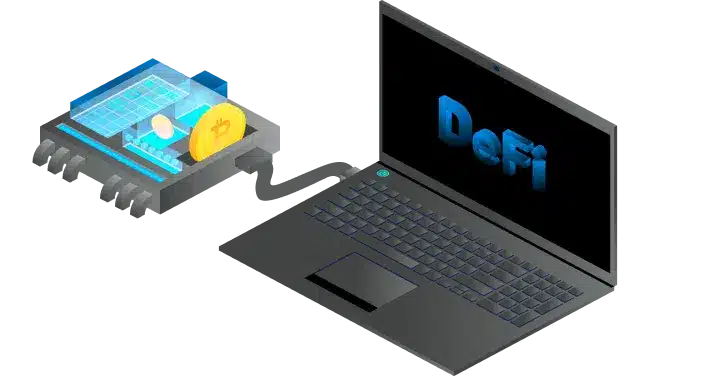

DeFi, short for Decentralized Finance, is an innovative, intermediary-independent, and code-based financial ecosystem aimed at revolutionizing the traditional financial system. It operates on the infrastructure of blockchain technology and smart contracts to create a transparent decentralized financial ecosystem. The users utilize decentralized applications to attain financial services while enabling direct peer-to-peer trading and exchanges. The interoperability within the DeFi system allows the integration of security protocols and decentralized autonomous organizations to involve stakeholders in decision-making. DeFi provides users with transparency, accessibility, and control over their financial record. This research report by Antier Solutions focuses upon the growing adoption trends of decentralized finance.

including the growth of the market and key players

The DeFi market has experienced exponential growth, with the total value locked (TVL) in DeFi protocols surging from a few million dollars to over $100 billion within a short span.
.png.webp)
Significant milestones such as crossing the $1 billion and $10 billion Total Value Locked (TVL) markers demonstrate robust expansion and investor interest.
.png.webp)
The DeFi ecosystem offers a myriad of financial services, including decentralized lending, borrowing, trading, yield farming, decentralized exchanges (DEXs), derivatives, etc.
According to our report, the following are the key players mostly used by DeFi users:

80% of the DeFi community uses Ethereum
.png.webp)
30% of the DeFi community uses Ethereum
.png.webp)
40% of the DeFi community utilizes compound for lending and borrowing digital assets.
.png.webp)
60% of the DeFi users engage with Uniswap for decentralized trading
.png.webp)
20% of DeFi users utilize Aave for accessing lending and borrowing services
.png.webp)
15% of the DeFi community utilize Synthetix for accessing synthetic assets.

DeFi has seen exponential adoption in the trading and investment sector, with many users turning to DeFi for faster, cheaper, and global trading. According to our reports, decentralized exchanges (DEXs) saw a total trading volume of over $120 billion in 2021.

DeFi lending and borrowing platforms have also seen rapid adoption rates because users prefer DeFi for easy access to loans and higher interest rates. According to our reports, the TVL in DeFi lending platforms was over $30 billion in 2022.

DeFi has the potential to disrupt the traditional payment and remittance industry, with many users adopting DeFi protocols for robust cross-border transactions. According to our analysis, DeFi payment and remittance protocols saw a total transaction volume of over $2 billion as of 2022.

DeFi insurance protocol is a new sector but has witnessed rapid adoption. According to our research statistics, the TVL in DeFi insurance protocols was over $12 billion in 2022.

DeFi gaming is an emerging sector. According to our report, DeFi gaming platforms saw a total transaction volume of over $5 billion in 2021.

While DeFi has not yet seen widespread adoption in the manufacturing sector, according to our surveys, 10-15% of manufacturing companies using DeFi applications, such as supply chain financing or asset tokenization.

The adoption rate is relatively low in healthcare systems. However, according to our research 5-10% of healthcare organizations or providers are adopting DeFi service.

DeFi has the potential to provide small businesses with greater access to financial services. However, adoption in this sector is still limited, only 15-20% of small businesses are utilizing DeFi services for financing, or lending.

The traditional financial landscape is disrupted by decentralized financing (DeFi), which is gaining momentum in recent years. By examining these attitudes and views, we can learn a great deal regarding what DeFi motivates adoption.
54% of respondents reported they consider DeFi a better financial option.
87% of respondents said they were interested in DeFi, and 68% of those people cited DeFi's ability to simplify access to financial services as the reason for that interest.
While 45% of DeFi customers identified concerns about conventional financial institutions as a factor in their adoption of DeFi, 63% were driven by the prospect of higher returns on their investments.
54% of respondents reported they consider DeFi a better financial option.
Financial Inclusion
Transparency
Global Accessibility
Improved Efficiency
Financial Inclusion
Financial Inclusion
Financial Inclusion
Financial Inclusion

According to our survey, the highest adoption rates are
Among individuals aged 18-34, 41% of respondents in this age group use DeFi.
27% of respondents aged 35-54 use DeFi.
16% of those age 55 or above use DeFi.

Our survey found that DeFi adoption rates among men and women are
Among individuals aged 18-34, 41% of respondents in this age group use DeFi.
27% of respondents aged 35-54 use DeFi.

The adoption rates of DeFi were higher among respondents with higher income levels.
Of respondents with an annual income of $100,000 or more, 41% reported using DeFi
25% of those with an annual income of less than $50,000 use DeFi.
To conclude, the market research report on DeFi reveals a remarkable growth in the adoption rate with a total value locked (TVL) exceeding $100 billion. DeFi offers a decentralized and a transparent financial system that provides total control over financial activities. The future outlook for DeFi is promising due to its market trend with projected growth rates, innovations and high interest rates from retails and investors. Additionally, the future outlook for decentralized finance (DeFi) is highly promising because according to our researched industry reports, the global DeFi market is expected to experience substantial growth, with a compound annual growth rate (CAGR) of over 45% from 2021 to 2028. This growth is due to rising demand of decentralized financial services and adoption of blockchain technology. Moreover, governments and organizations are providing the legal framework for DeFi services henceforth increasing the adoption of DeFi. The legitimacy of DeFi is attracting a wider audience. Furthermore, the technological advancements are also contributing to the bright future of DeFi. With many projects, investments and worldwide usage, DeFi is well- positioned to reshape the financial landscape and unlocking new possibilities for financial inclusion.

The Antier Solutions Market Report on DeFi Adoption provides a comprehensive analysis of the current state and trends in decentralized finance adoption. This report incorporates a combination of qualitative and quantitative data indicating that we used a multi-faceted research methodology. We did a comparative analysis of different research reports to identify various trends, attitude of users and patterns in the adoption of DeFi worldwide. The report consists of data analysis, where our experts compared adoption rates across different sectors, countries, and demographics. We used this data and used statistical methods to derive meaningful insights from the collected data.